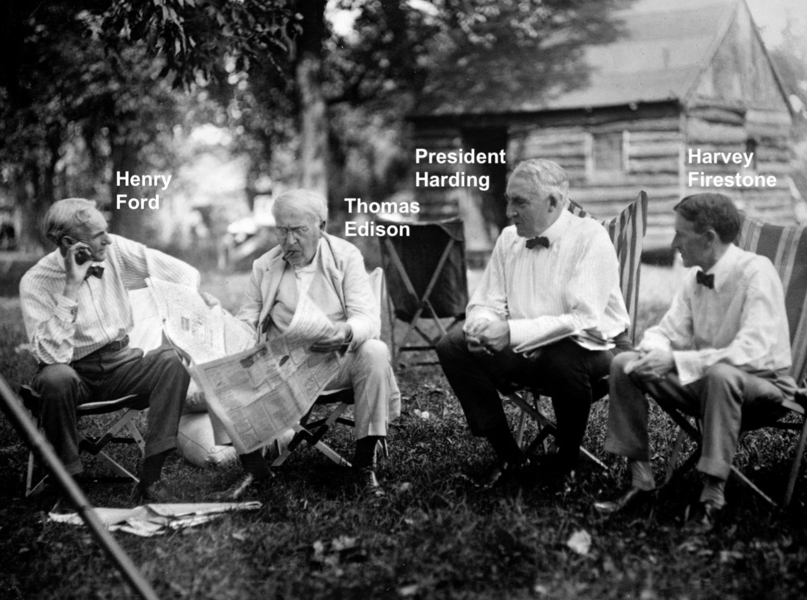
The founder of the Firestone Tire and Rubber Company, Harvey Firestone knew the value of motorsports in promoting his product, a legacy that continues today. Firestone is credited with innovations such as the pneumatic tire, the demountable rim, the first angular non-skid tread, which made automobiles easier to control; the gum-dipping process, which guarded against heat build-up; and the first successful set of low- pressure balloon tires that allowed cars to travel at faster speeds with greater safety and comfort. Firestone's tires made their first official racing appearance in 1909 when he put a set on a car driven by Barney Oldfield in a 300 mile race held at the just-built Indianapolis Motor Speedway. During testing, Oldfield reportedly told onlookers “my only life insurance is my Firestone tires.” He and Firestone later had the phrase painted on the side of his race car, and he toured the country “performing amazing feats of speed.” Hall of Famer Ray Harroun won the inaugural Indianapolis 500 in 1911 on Firestone tires. During these early competitions, tires were not built specifically for racing as is the case today. To demonstrate product quality and durability, the first race tires were actually the same tires sold for everyday use on roads or streets. Firestone believed that if the public saw how well the his tires performed on the track, they would want them for their own vehicles. Between 1920 and 1966, there were 43 Indianapolis 500-Mile Races (no events were conducted during the World War II years), all won by drivers on Firestone tires. The company started by Harvey Firestone early in the 1900's is still active in motorsports over a century later. In the early years of NASCAR, Firestone tires were on the winners of nearly 600 Cup races. Despite a 20-year hiatus (1974-1995) from Indy car racing, Firestone has accumulated a total of well over 800 Indy car race wins, including over 60 Indy 500s.
By Bob Troyer
Harvey S. Firestone was a man of simple roots whose vision and entrepreneurial spirit enabled him to take advantage of the early 20th century emergence of the automotive industry to build a global enterprise bearing his name.
Firestone was born on a farm near Columbiana, Ohio, in 1868. After completing high school, he moved to Detroit as district manager of a buggy company. He often rode around in one of the city's first rubber-tired carriages. While in Detroit, he sold a set of tires to another young automotive enthusiast named Henry Ford, a machinist who was beginning to experiment with gasoline engines and who would later become a valued business associate and close friend. Firestone left the buggy company in 1896 and went to Chicago where he bought a downtown tire shop. He was approached several years later to sell his shop at an attractive price.
In 1900, Harvey relocated to Akron, where there were already more than 30 companies producing tires. With $20,000 from the sale of his Chicago business and patents for securing tires to wheels, he established The Firestone Tire & Rubber Company.
Firestone's skills in marketing and product innovation helped his business stand apart from his competitors. His company became known for its pioneering efforts in passenger, truck and farm tires, innovations in production processes, and early involvement in racing to showcase the durability of its products. By 1909, Firestone had teamed up with daredevil Barney Oldfield, who was barnstorming racetracks to thrill fans in his Firestone-equipped racecar. Oldfield won the Indianapolis Sweepstakes in 1909 -- a 300-mile race -- after which he proclaimed what may have been the first marketing tie-in to motorsports:
"My only life insurance is my Firestone tires."
The first Indianapolis 500 in 1911 was won by Ray Harroun on Firestones and the company began aggressively marketing its racing successes. Advertisements soon touted that tires winning at Indianapolis and other venues were not specially made, but stock tires that "any motorist gets when buying Firestone."
Firestone and his company continued to use racing as a proving ground, including developments such as non-skid treads, low pressure balloon tires and gum-dipping to insulate cords against heat. In 1920, Firestone began what became an incredible record: 47 consecutive years equipping the winning cars in the Indianapolis 500.
In recognition of his role as "a pioneer patron of Indianapolis racing," Firestone served as referee for the 1929 Indianapolis 500. The following year, he was presented a medal from the Race Drivers Association for his leadership in developing tires that contributed to "automobile safety and endurance records." Firestone died in early 1938, leaving behind a company that had become one of America's leading corporations. The company was acquired by Bridgestone in 1988.
In the early days of his enterprise, Harvey Firestone recognized the importance of motorsports in promoting the safety and durability of his products. More than 100 years later, "Win on Sunday, sell on Monday" remains a Firestone tradition.
Bridgestone President of Original Equipment, U.S. and Canada Consumer Tire Sales Divisions, Mike Martini (R) with Nick Firestone who accepted on behalf of his great-grandfather
(MSHFA)